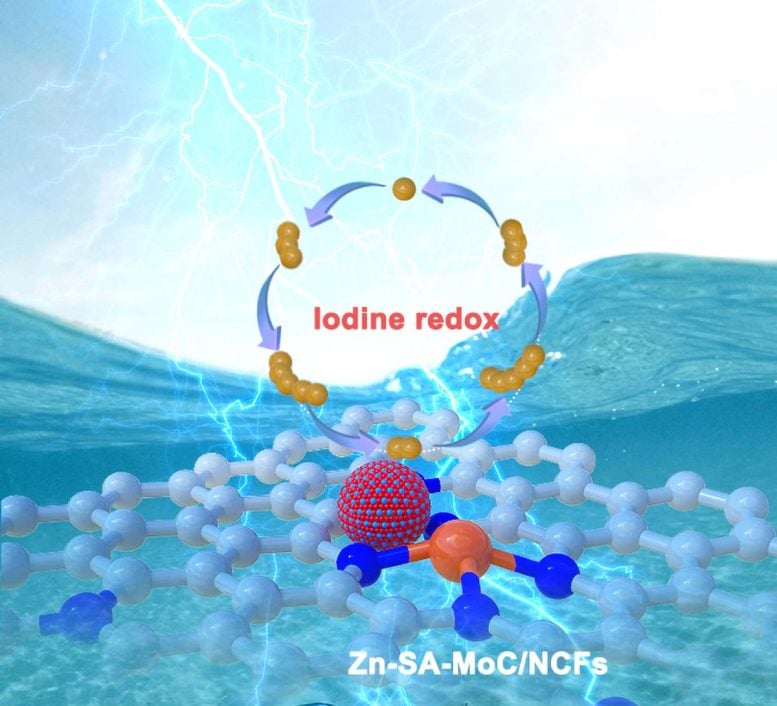博文
新一代Zn-I2电池:高容量满足长期耐用性
 精选
精选
||
新一代Zn-I2电池:高容量满足长期耐用性
诸平
据《科技日报》(SciTechDaily)网站2025年1月5日刊发来自中国科学出版社(Science China Press)提供的消息,新一代Zn-I2电池:高容量满足长期耐用性(Next-Gen Zinc-I2 Batteries: High Capacity Meets Long-Term Durability)。
研究人员利用Zn-SA-MoC/ NFCs开发了一种新型的Zn-I2电池设计,克服了碘(I)的限制,实现了高容量(230.6 mAh/g)和耐用性(20,000次循环后保持90%)。相关研究结果于2024年11月28日已经在《科学通报》(Science Bulletin)杂志发表——Song Chen, Jizhen Ma, Qianwu Chen, Wenshuo Shang, Jinshuai Liu, Jintao Zhang. Exploring interfacial electrocatalysis for iodine redox conversion in zinc-iodine battery. Science Bulletin, 28 November 2024. DOI: 10.1016/j.scib.2024.11.042
水性锌离子电池(zinc-ion batteries简称ZIBs)因其高安全性、原材料广泛可用性和环境兼容性而受到广泛关注。
碘在海水中含量丰富(55 μg/L),具有较高的理论容量(211 mAh/g)和合适的氧化还原电位(0.54 V),在锌碘电池(zinc-iodine batteries)中具有很大的应用潜力,但碘的低电导率限制了能量储存过程中有效的氧化还原转化。此外,形成的可溶性多碘化物可以迁移到锌阳极,导致容量下降和锌腐蚀。
解决关键挑战:创新材料设计(Addressing Key Challenges: Innovative Material Design)
为了解决Zn- I2电池中存在的问题,研究小组提出了沉淀法,将钼酸盐离子(molybdate ions)封装到沸石型米唑盐框架-8 (zeolitic imidazolate framework-8简称ZIF-8)中,然后通过静电纺丝和煅烧制备具有Zn单原子(Zn-SA)位和碳化钼团簇(molybdenum carbide clusters)的独立多孔碳纤维(Zn-SA-MoC/NCFs)。
由于分层多孔碳结构具有良好的传质性能,碳化钼与单原子催化剂的结合有望增强对碘的吸附能力,并以最佳的电荷再分配调节催化活性。因此,组装的Zn- I2电池在0.5 C (1 C= 0.211 mA/cm2)电流密度下具有230.6 mAh/g的大比容量,并且在20000次循环后保持90%的良好容量。
增强电催化和更广泛的影响(Enhanced Electrocatalysis and Broader Implications)
通过对MoC簇加入Zn-SA增强电催化作用的基本认识,对主体与碘离子之间电子结构调制的概念研究,为高性能Zn-I2电池及其他领域的研究提供了基本原理。
这项研究首次证明了通过在碘氧化还原反应中加入Zn-N4位点来操纵MoC簇的电催化活性。该电子结构调控策略为构建先进的碘催化剂和优化其电池性能提供了强有力的指导。
上述介绍,仅供参考。欲了解更多信息,敬请注意浏览原文或者相关报道。
The challenges posed by the non-conductive nature of iodine, coupled with the easy formation of soluble polyiodides in water, impede its integration with zinc for the development of advanced rechargeable batteries. Here we demonstrate the in-situ loading of molybdenum carbide nanoclusters (MoC) and zinc single atoms (Zn-SA) into porous carbon fibers to invoke electrocatalytic conversion of iodine at the interface. The electronic interactions between MoC and Zn-SA lead to an upshift in the d-band center of Mo relative to the Fermi level, thus promoting the interfacial interactions with iodine species to suppress shuttle effects. Notably, the optimal charge delocalization, induced by d-p orbital hybridization between molybdenum and iodine, also lowers the redox energy barrier to promote the interfacial conversion. With interfacial electrocatalysis minimizing polyiodide intermediates via a favorable redox conversion pathway, zinc-iodine batteries therefore demonstrate a large specific capacity of 230.6 mAh g−1 and the good capacity retention for 20,000 cycles.
https://blog.sciencenet.cn/blog-212210-1467582.html
上一篇:Nature:天冬氨酸引发肺癌
下一篇:睡眠革命:磁脉冲如何治疗失眠
